-
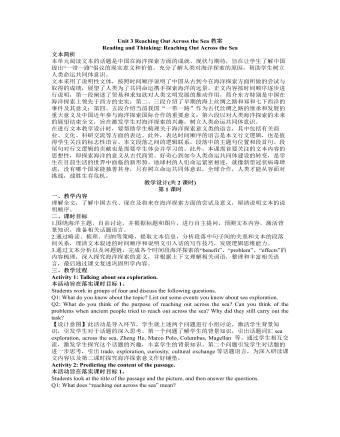
新人教版高中英语选修4Unit 3 Reaching Out Across the Sea教案
本活动旨在落实课时目标3。 Think about the following questions and talk about your own attitude in pairs.Q1: As for this topic,what impresses you the most in the passage?Q2: What do you think of the future of China’s further exploration in sea? Are you in favor of the further exploration?Why or why not? 【设计意图】该活动是一个完全开放性的活动,每个学生都会有不同的答案。运用迁移所学,自由口头表达自己对海洋探索的态度。对于中国海洋探索的未来,每个人的想法是不一样的,有乐观,有担忧,有认为值得投入,也有认为不值得付出太大代价,这里给学生自由表达的空间只要学会有支撑自己观点的事实就可以了,进一步培养学生批判性思维和正确的价值观。 Assignment: 此任务旨在迁移一、二课时所学,培养学生辩证分析问题的能力。 Write about your idea of the future of China’s sea exploration. And add your attitude towards the effort China have made in sea exploration. You’re expected to use the language and the writing technique learnt in the passage.
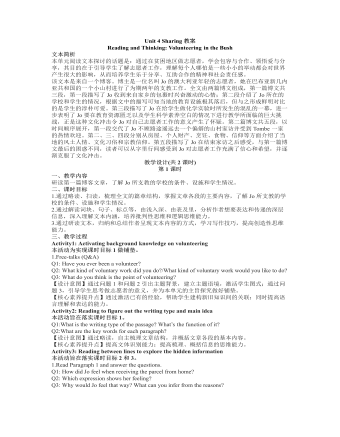
新人教版高中英语选修4Unit 4 Sharing教案
【核心素养提升点】学会将抽象信息进行可视化表达,提高信息处理能力和分析、推理等高阶思维品质;在跨文化交际中学会以国际视野接受和包容不同的文化。 5.Read Paragraph 2, draw a mind map and answer the questions. Q1:What did Jo learn about Tombe’s life? Q2:What kind of life do the natives lead? Read paragraph 2-5 and draw a mind-map. (Focus on accommodation, possession, diet and belief) 【设计意图】引导学生利用思维导图和问题链等形式来厘清当地人的生活方式,更好地处理和归纳信息 【核心素养提升点】提高信息处理能力、分析和归纳能力,包容异国文化、扩展国际视野。 6.Read Paragraph 3 and answer the questions. Q1:What was Jo’s feeling upon arriving her own home? Q2:Why would she feel that way? Q3:Do you think “It was such a privilege to have spent a day with Tombe’s family”? 【设计意图】通过提问,让学生理解Jo的苦并快乐的心情,并通过对“It was such a privilege to have spent a day with Tombe’s family”这句话的理解,体验志愿者生活的伟大。 【核心素养提升点】学会对信息的综合和归纳,从而理解作者所表达的观点。 Activity4: Summarize the change of Jo's feelings
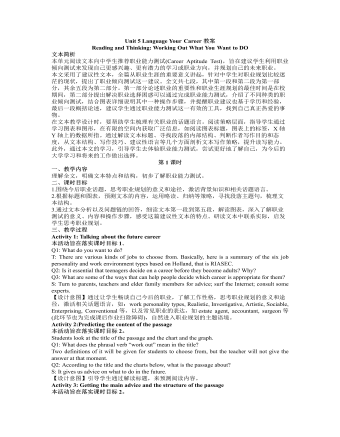
新人教版高中英语选修4Unit 5 Language Your Career教案
本单元阅读文本向中学生推荐职业能力测试(Career Aptitude Test),旨在建议学生利用职业倾向测试来发现自己更感兴趣、更有潜力的学习或职业方向,并规划自己的未来职业。 本文采用了建议性文本,全篇从职业生涯的重要意义讲起,针对中学生对职业规划比较迷茫的现状,提出了职业倾向测试这一建议。全文共七段,其中第一段和第二段为第一部分,其余五段为第二部分。第一部分论述职业的重要性和职业生涯规划的最佳时间是在校期间,第二部分提出解决职业选择困惑可以通过完成职业能力测试,介绍了不同种类的职业倾向测试,结合图表详细说明其中一种操作步骤,并提醒职业建议也基于学历和经验,最后一段概括论述,建议学生通过职业能力测试这一有效的工具,找到自己真正热爱的事物。 在文本教学设计时,要帮助学生梳理有关职业的话题语言。阅读策略层面,指导学生通过学习图表和图形,在有限的空间内获取广泛信息,如阅读图表标题,图表上的标签,X轴Y轴上的数据所指。
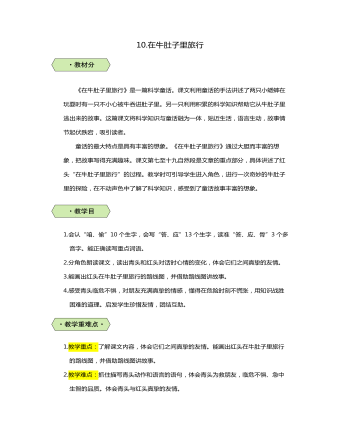
三年级语文在牛肚子里旅行教案
《在牛肚子里旅行》是一篇科学童话。课文利用童话的手法讲述了两只小蟋蟀在玩耍时有一只不小心被牛吞进肚子里。另一只利用积累的科学知识帮助它从牛肚子里逃出来的故事。这篇课文将科学知识与童话融为一体,贴近生活,语言生动,故事情节起伏跌宕,吸引读者。童话的最大特点是具有丰富的想象。《在牛肚子里旅行》通过大胆而丰富的想象,把故事写得充满趣味。课文第七至十九自然段是文章的重点部分,具体讲述了红头“在牛肚子里旅行”的过程。教学时可引导学生进入角色,进行一次奇妙的牛肚子里的探险,在不动声色中了解了科学知识,感受到了童话故事丰富的想象。
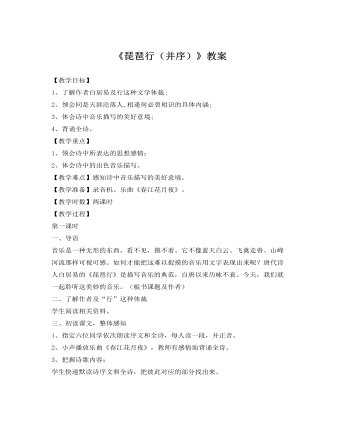
人教版高中语文《琵琶行》教案
二、有关评述1.(《锦瑟》)此悼亡诗也。意亡者善弹此,故睹物思人,因而托物起兴也。瑟本二十五弦,弦断而为五十弦矣,故曰“无端”也,取断弦之意也。“一弦一柱”而接“思华年”,二十五而殁也。“蝴蝶”“杜鹃”,言已化去也;“珠有泪”,哭之也;“玉生烟”,葬之也,犹言埋香瘗(yì)玉也。此情岂待今日追忆乎?只是当时生存之日,已常忧其至此而预为之惘然,必其婉弱多病,故云然也。(清·朱彝尊《李义山诗集》评语)2.诗以锦瑟起兴,“无端”二字便有自讶自怜之意,此锦瑟之弦遂五十耶?瑟之柱如其弦,而人之年已历历如其柱矣,即孔北海所谓五十之年忽忽至也。庄生梦醒,化蝶无踪,望帝不归,啼鹃长托,以比华年之难再也。感激而明珠欲泪,绸缪而暖玉生烟,华年之情尔尔。不但今日追忆无从,而在当日已成虚负,故曰“惘然”。(清·杜诏、杜庭珠《唐诗叩弹集》评语)
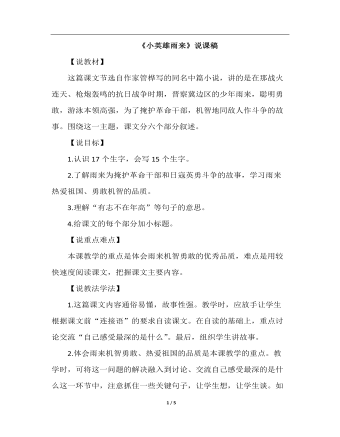
小英雄雨来(说课稿)
1.认识17个生字,会写15个生字。2.了解雨来为掩护革命干部和日寇英勇斗争的故事,学习雨来热爱祖国、勇敢机智的品质。3.理解“有志不在年高”等句子的意思。4.给课文的每个部分加小标题。【说重点难点】本课教学的重点是体会雨来机智勇敢的优秀品质,难点是用较快速度阅读课文,把握课文主要内容。
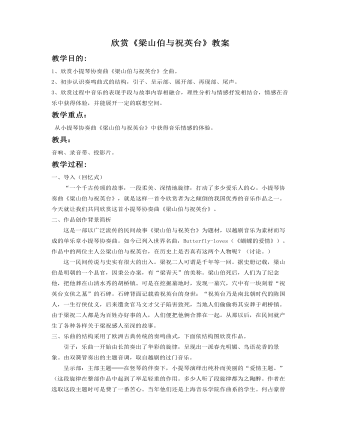
欣赏《梁山伯与祝英台》教案
一、导入(回忆式) “一个千古传颂的故事,一段柔美、深情地旋律,打动了多少爱乐人的心。小提琴协奏曲《梁山伯与祝英台》,就是这样一首令欣赏者为之倾倒的我国优秀的音乐作品之一。今天就让我们共同欣赏这首小提琴协奏曲《梁山伯与祝英台》。二、作品创作背景简析这是一部以广泛流传的民间故事《梁山伯与祝英台》为题材,以越剧音乐为素材而写成的单乐章小提琴协奏曲。如今已列入世界名曲,Butterfly-loves(《蝴蝶的爱情》)。作品中的两位主人公梁山伯与祝英台,在历史上是否真有这两个人物呢?(讨论。)这一民间传说与史实有很大的出入。梁祝二人可谓是千年等一回。据史册记载,梁山伯是明朝的一个县官,因秉公办案,有“梁青天”的美称。梁山伯死后,人们为了纪念他,把他葬在山清水秀的胡桥镇。可是在挖掘墓地时,发现一墓穴,穴中有一块刻着“祝英台女侠之墓”的石碑。石碑背面记载着祝英台的身世:“祝英台乃是南北朝时代的陈国人,一生行侠仗义,后来遭贪官马文才父子陷害致死,当地人们偷偷将其安葬于胡桥镇。由于梁祝二人都是为百姓办好事的人,人们便把他俩合葬在一起。从那以后,在民间就产生了各种各样关于梁祝感人至深的故事。三、乐曲的结构采用了欧洲古典传统的奏鸣曲式,下面依结构图欣赏作品。引子:乐曲一开始由长笛奏出了华彩的旋律,呈现出一派春光明媚、鸟语花香的景象。由双簧管奏出的主题音调,取自越剧的过门音乐。呈示部:主部主题──在竖琴的伴奏下,小提琴演绎出纯朴而美丽的“爱情主题。”(这段旋律在整部作品中起到了举足轻重的作用。多少人听了段旋律都为之陶醉。作者在选取这段主题时可是费了一番苦心。当年他们还是上海音乐学院作曲系的学生。何占豪曾在杭州越剧团当演员,他对越剧音乐既熟悉又喜爱。在创作《梁祝》时,故事流传在浙江一带,越剧是浙江的代表剧种,他决心从越剧音乐中取材。据平时的观察,许多越剧名演员,不论他们演出任何剧目,只要唱到一段唱腔时,台下都会博得热烈地掌声为之呼应。作者抓住了这段唱腔作为《梁祝》中“爱情主题”的基本音调。这段主题是全曲的核心的音调。)
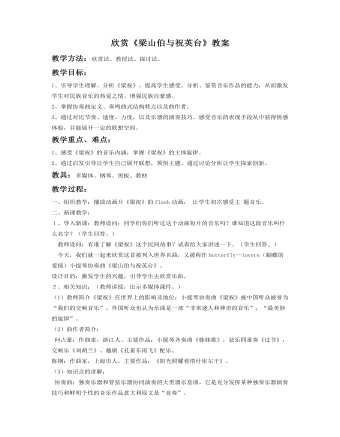
欣赏《梁山伯与祝英台》教案
教学过程:一、组织教学:播放动画片《梁祝》的flash动画, 让学生初次感受主 题音乐。二、新课教学:1、导入新课:教师设问:同学们你们听过这个动画短片的音乐吗?谁知道这段音乐叫什么名字?(学生回答。) 教师设问:有谁了解《梁祝》这个民间故事?试着给大家讲述一下。(学生回答。) 今天,我们就一起来欣赏这首被列入世界名曲,又被称作butterfly—lovers(蝴蝶的爱情)小提琴协奏曲《梁山伯与祝英台》。设计目的:激发学生的兴趣,引导学生去欣赏乐曲。2、相关知识:(教师讲授,出示多媒体课件。)(1)教师简介《梁祝》在世界上的影响及地位:小提琴协奏曲《梁祝》被中国听众被誉为“我们的交响音乐”。外国听众也认为乐曲是一部“非常迷人和神奇的音乐”,“最美妙的旋律”。(2)曲作者简介: 何占豪:作曲家,浙江人。主要作品:小提琴齐奏曲《姊妹歌》,弦乐四重奏《过节》,交响乐《刘胡兰》、越剧《孔雀东南飞》配乐。陈钢:作曲家,上海市人。主要作品:《阳光照耀着塔什库尔干》。(3)知识点的讲解: 协奏曲:独奏乐器和管弦乐器协同演奏的大型器乐套曲,它是充分发挥某种独奏乐器演奏技巧和鲜明个性的音乐作品意大利原文是“竞奏”。3、下面,欣赏《梁祝》的主要部分音乐。
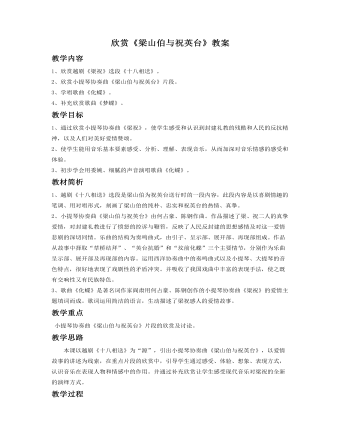
欣赏《梁山伯与祝英台》教案
教学过程第一环节:恋蝶——欣赏越剧《十八相送》感受越剧韵味,了解越剧。 1、提问导入特点,并为欣赏下一作品做好铺垫。(1)越剧是浙江地方戏剧剧种之一,你能说出一些著名的越剧代表作品吗?(2)导出越剧《梁祝》并请学生说说梁祝故事。(3)教师小结。(4)欣赏越剧《十八相送》。(5)简单介绍越剧特点(唱腔、语言)。第二环节:颂碟——欣赏小提琴协奏曲《梁祝》片断。1、导入:介绍作品地相关知识。(1)教师:这个千古传颂的爱情故事可以用越剧的形式来表现。那么,我们是否可以用其他形式来表现呢?我们中国就有两位作曲家何占豪和陈刚,他们为了探索交响音乐的民族化,选择了这一家喻户晓的民间传说为题材,吸取越剧中的曲调为素材,运用西洋手法,成功地创作了一部小提琴协奏曲《梁祝》。(2)介绍乐器小提琴、大提琴(出示图片)。 2、欣赏“爱情主题”(1)请学生聆听爱情主题音乐根据提问,让学生思考:①这段主旋律由哪样乐器演奏? ②这段主旋律有什么特点?自主参与讨论分析作品。(2)学生思考并回答。(3)教师总结: 旋律优美动听、委婉曲折,带有越剧韵味。节奏舒缓,情绪明朗。表现出爱情的美好。3、介绍协奏曲 协奏曲是指一种由独奏乐器与管弦乐队协同演奏的大型器乐作品。在音乐 进行中,独奏乐器与乐队常常轮流出现,独奏时乐队处于伴奏地位。全奏时,独奏乐器休止,完全由乐队演奏。
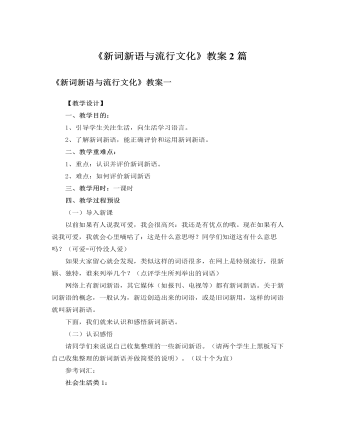
人教版高中语文必修1《新词新语与流行文化》教案2篇
【教学设计】一、教学目的:1、引导学生关注生活,向生活学习语言。2、了解新词新语,能正确评价和运用新词新语。二、教学重难点:1、重点:认识并评价新词新语。2、难点:如何评价新词新语三、教学用时:一课时四、教学过程预设(一)导入新课以前如果有人说我可爱,我会很高兴:我还是有优点的哦。现在如果有人说我可爱,我就会心里嘀咕了:这是什么意思呀?同学们知道这有什么意思吗?(可爱=可怜没人爱)如果大家留心就会发现,类似这样的词语很多,在网上是特别流行,很新颖、独特,谁来列举几个?(点评学生所列举出的词语)网络上有新词新语,其它媒体(如报刊、电视等)都有新词新语。关于新词新语的概念,一般认为,新近创造出来的词语,或是旧词新用,这样的词语就叫新词新语。
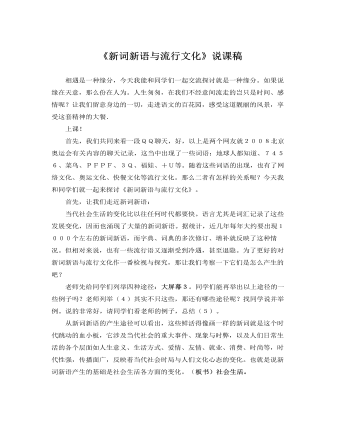
人教版高中语文必修1《新词新语与流行文化》说课稿
当代社会生活的变化比以往任何时代都要快。语言尤其是词汇记录了这些发展变化,因而也涌现了大量的新词新语。据统计,近几年每年大约要出现1000个左右的新词新语,而字典、词典的多次修订、增补就反映了这种情况。但相对来说,也有一些流行语又逐渐受到冷遇,甚至退隐。为了更好的对新词新语与流行文化作一番检视与探究,那让我们考察一下它们是怎么产生的吧?老师先给同学们列举四种途径:大屏幕3。同学们能再举出以上途径的一些例子吗?老师列举(4)其实不只这些,那还有哪些途径呢?找同学说并举例。说的非常好,请同学们看老师的例子,总结(5)。从新词新语的产生途径可以看出,这些鲜活得像画一样的新词就是这个时代跳动的血小板,它涉及当代社会的重大事件、现象与时弊,以及人们日常生活的各个层面如人生意义、生活方式、爱情、友情、就业、消费、时尚等,时代性强,传播面广,反映着当代社会时局与人们文化心态的变化。
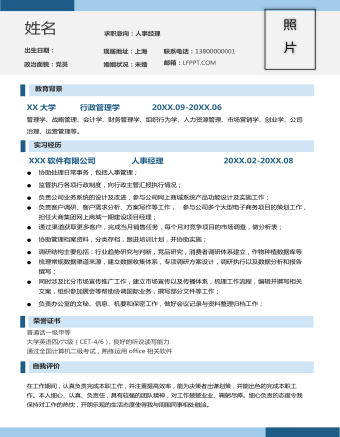
人事经理人事行政类求职简历模板
l 协助处理日常事务,包括人事管理;l 监管执行各项行政制度,向行政主管汇报执行情况;l 负责公司业务系统的设计及改进,参与公司网上商城系统产品功能设计及实施工作;l 负责客户调研、客户需求分析、方案写作等工作, 参与公司多个大型电子商务项目的策划工作,担任大商集团网上商城一期建设项目经理;l 通过渠道获取更多客户,完成当月销售任务,每个月对竞争项目的市场调查,做分析表;l 协助管理档案资料,分类存档,跟进培训计划,并协助实施;
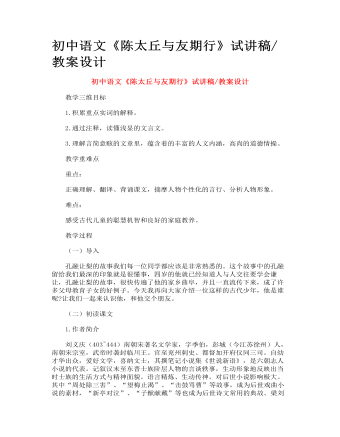
初中语文《陈太丘与友期行》试讲稿_教案设计
刘义庆(403~444)南朝宋著名文学家,字季伯,彭城(今江苏徐州)人,南朝宋宗室,武帝时袭封临川王。官至兖州刺史、都督加开府仪同三司。自幼才华出众,爱好文学,喜纳文士,其撰笔记小说集《世说新语》,是六朝志人小说的代表。记叙汉末至东晋士族阶层人物的言谈轶事,生动形象地反映出当时士族的生活方式与精神面貌。语言精炼、生动传神,对后世小说影响极大。其中“周处除三害”、“望梅止渴”、“击鼓骂曹”等故事,成为后世戏曲小说的素材,“新亭对泣”、“子猷献戴”等也成为后世诗文常用的典故。梁刘孝标作注,旁征博引,为后人所重。另有《幽明录》,今佚。鲁迅《古小说钩沉》辑其佚文200余条,皆记诡异之事。
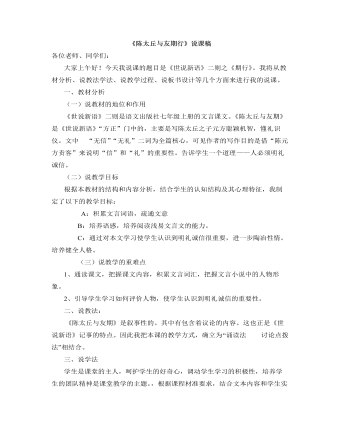
部编版语文七年级上册《陈太丘与友期行》说课稿
各位老师、同学们:大家上午好!今天我说课的题目是《世说新语》二则之《期行》。我将从教材分析、说教法学法、说教学过程、说板书设计等几个方面来进行我的说课。一、教材分析(一)说教材的地位和作用《世说新语》二则是语文出版社七年级上册的文言课文。《陈太丘与友期》是《世说新语》“方正”门中的,主要是写陈太丘之子元方聪颖机智,懂礼识仪。文中 “无信”“无礼”二词为全篇核心,可见作者的写作目的是借“陈元方责客”来说明“信”和“礼”的重要性。告诉学生一个道理——人必须明礼诚信。(二)说教学目标根据本教材的结构和内容分析,结合学生的认知结构及其心理特征,我制定了以下的教学目标:A:积累文言词语,疏通文意B:培养语感,培养阅读浅易文言文的能力。
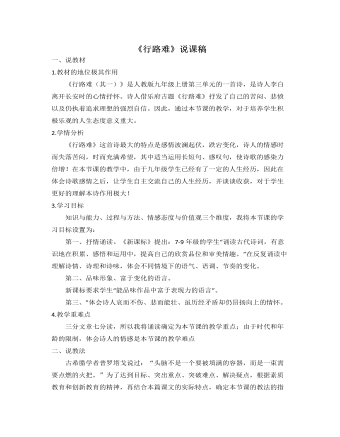
部编版语文九年级上册《行路难》说课稿
一、说教材1.教材的地位极其作用《行路难(其一)》是人教版九年级上册第三单元的一首诗,是诗人李白离开长安时的心情抒怀。诗人借乐府古题《行路难》抒发了自己的苦闷、悲愤以及仍执着追求理想的强烈自信。因此,通过本节课的教学,对于培养学生积极乐观的人生态度意义重大。2.学情分析《行路难》这首诗最大的特点是感情波澜起伏,跌宕变化,诗人的情感时而失落苦闷,时而充满希望,其中适当运用长短句、感叹句,使诗歌的感染力倍增!在本节课的教学中,由于九年级学生已经有了一定的人生经历,因此在体会诗歌感情之后,让学生自主交流自己的人生经历,并谈谈收获,对于学生更好的理解本诗作用极大!3.学习目标知识与能力、过程与方法、情感态度与价值观三个维度,我将本节课的学习目标设置为:
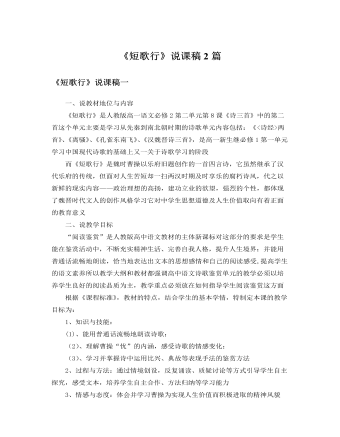
人教版高中语文必修2《短歌行》说课稿2篇
一、说教材《短歌行》是普通高中课程标准实验教科书必修(二)第二单元的一篇略读课文,本单元安排的是先秦到南北朝时期的诗歌。《短歌行》是著名政治家、军事家、文学家曹操的作品。诗中抓住“忧”字来写诗人为什么“忧”,如何解“忧”,从而表达希望能够招揽人才、完成统一天下的雄心壮志。所以本单元安排《短歌行》一诗,对学生全面了解曹操,感受曹操在短暂的人生中竭力创造伟业的气概。二、说学生我这一课的教学对象是高一学生。他们进入高中学习的时间只有三个多月,现在已经完成了必修(一)的学习。学习了现代诗歌单元,有了一定的诗歌学习基础,初步掌握了读诗的基本方法,但是还未能形成成熟的稳定的学习方式。同时,本单元学习是高中第一次接触古代诗歌,诗歌语言上的障碍和时间上的跨度对他们来说都是学习上的困难。因此教师要引导学生自主学习,合作学习,为他们设置新的学习情境,提供合作探究的机会。

人教版高中语文必修2《短歌行》教案2篇
教学过程:一、导语毛泽东在《沁园春雪》俯视封建君王“惜秦皇汉武。。。只识弯弓射大雕。”但如果历史上只有一个人可以与他相提并论,这个人只能是魏武帝曹操。“滚滚长江东逝水,浪花淘尽英雄。是非成败转头空,青山依旧在,几度夕阳红。”(《三国演义》卷首词)在历史的大浪淘沙中,有多少英雄能够经得起历史的千淘万漉而流芳百世呢?曹操应该是三国时代留下了浓重一笔的人物。老师总结,并启发他们去联系:我们学过他的《观沧海》“东临碣石,以观沧海…”还有《龟虽寿》“神龟虽寿,猷有竟时。老骥伏枥,志在千里;烈士暮年,壮心不已。”《青梅煮洒论英雄》中曾和他见过,《三国演义》电视剧播出后,大家和他也就频频见面了。《三国演义》第48回“宴长江曹操赋诗”中,赤壁之战前夕,曹操和众部将一起狂饮,他四顾空阔,心中大喜,与诸将讲述自己希望收服江南的雄心壮志。

人教版高中语文必修3《琵琶行 并序》教案
9、在乐曲终了之后,诗人以“东船西舫悄无言,唯见江心秋月白”两句结尾,这两句作用如何?明确:诗人没有直接写听者的热烈反响以说明琵琶女技艺非凡和乐声的感人至深,否则过于直白就不含蓄,不含蓄也就显不出深沉了。用“东船西舫悄无言”的寂静无声,反衬“有声”的音乐效果,可谓“此时无声胜有声”了。人们无声地沉浸、陶醉在艺术的享受之中,那深深打动人的乐声仿佛缭绕迂回耳际,不由得使诗人想到了自己浩茫的心事,引起情绪上的波澜。在这片刻的沉寂中,只见一轮迷蒙的冷月荡漾在江心的微波之中,它提醒诗人从乐声中回到现实中来。这句景物描写点染烘托了浓重的氛围,与复杂的乐声融为一体,共同表现了琵琶女与诗人息息相通的复杂情感,是那么的忧愤、哀怨凄楚、苍凉,给整个音乐形象补足了画龙点睛之笔。
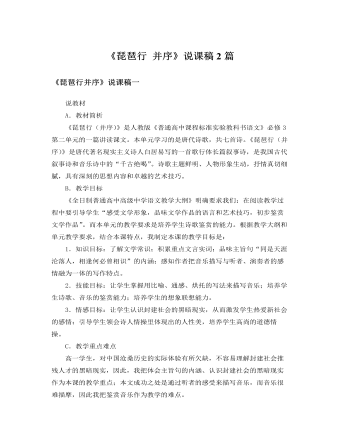
人教版高中语文必修3《琵琶行 并序》说课稿2篇
说教材A.教材简析《琵琶行(并序)》是人教版《普通高中课程标准实验教科书语文》必修3第二单元的一篇讲读课文。本单元学习的是唐代诗歌,共七首诗。《琵琶行(并序)》是唐代著名现实主义诗人白居易写的一首歌行体长篇叙事诗,是我国古代叙事诗和音乐诗中的“千古绝喝”。诗歌主题鲜明、人物形象生动,抒情真切细腻,具有深刻的思想内容和卓越的艺术技巧。B.教学目标《全日制普通高中高级中学语文教学大纲》明确要求我们:在阅读教学过程中要引导学生“感受文学形象,品味文学作品的语言和艺术技巧,初步鉴赏文学作品”。而本单元的教学要求是培养学生诗歌鉴赏的能力。根据教学大纲和单元教学要求,结合本课特点,我制定本课的教学目标是:1.知识目标:了解文学常识;积累重点文言实词;品味主旨句“同是天涯沦落人,相逢何必曾相识”的内涵;感知作者把音乐描写与听者、演奏者的感情融为一体的写作特点。
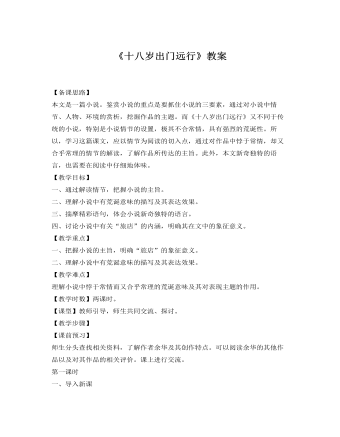
人教版高中语文《十八岁出门远行》教案
【备课思路】本文是一篇小说。鉴赏小说的重点是要抓住小说的三要素,通过对小说中情节、人物、环境的赏析,挖掘作品的主题。而《十八岁出门远行》又不同于传统的小说,特别是小说情节的设置,极其不合常情,具有强烈的荒诞性。所以,学习这篇课文,应以情节为阅读的切入点,通过对作品中悖于常情,却又合乎常理的情节的解读,了解作品所传达的主旨。此外,本文新奇独特的语言,也需要在阅读中仔细地体味。【教学目标】一、通过解读情节,把握小说的主旨。二、理解小说中有荒诞意味的描写及其表达效果。三、揣摩精彩语句,体会小说新奇独特的语言。四、讨论小说中有关“旅店”的内涵,明确其在文中的象征意义。【教学重点】一、把握小说的主旨,明确“旅店”的象征意义。二、理解小说中有荒诞意味的描写及其表达效果。

